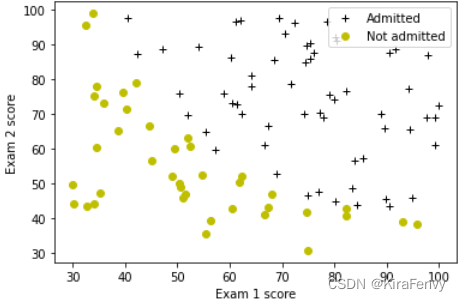【Machine Learning】13.逻辑回归小结and练习
逻辑回归小结
- 1.导入
- 2.逻辑回归
- 2.1 问题陈述
- 2.2 数据加载和可视化
- 2.3 Sigmoid函数
- Exercise 1
- 2.4 逻辑回归的代价函数 Cost function for logistic regression
- Exercise 2
- 2.5 逻辑回归的梯度下降
这节回顾一下之前的逻辑回归、正则化的理论知识并实践(光看代码不敲代码可不行啊)
1.导入
import numpy as np
import matplotlib.pyplot as plt
from utils import *
import copy
import math
%matplotlib inline
2.逻辑回归
在这部分练习中,你将建立一个逻辑回归模型来预测学生是否被大学录取。
2.1 问题陈述
假设你是一所大学系的管理员,你想根据两次考试的结果来确定每个申请人的入学机会。
-
您有以前申请者的历史数据,可以用作逻辑回归的培训集。
-
对于每个培训示例,您都有申请人在两次考试中的分数以及录取决定。
-
你的任务是建立一个分类模型,根据这两门考试的分数估计申请者的录取概率。
2.2 数据加载和可视化
您将从加载此任务的数据集开始。
- 下面显示的
load_dataset()函数将数据加载到变量X_train和y_train中 X_train包含学生两次考试的成绩- “y_train”是录取决定
y_train=1如果学生被录取y_train=0如果学生未被录取X_train和`y_train’都是numpy数组。
加载数据
# load dataset
X_train, y_train = load_data("data/ex2data1.txt")
熟悉一下数据集
print("First five elements in X_train are:\n", X_train[:5]) #查看前五条数据
print("Type of X_train:",type(X_train))
First five elements in X_train are:
[[34.62365962 78.02469282]
[30.28671077 43.89499752]
[35.84740877 72.90219803]
[60.18259939 86.3085521 ]
[79.03273605 75.34437644]]
Type of X_train: <class 'numpy.ndarray'>
print("First five elements in y_train are:\n", y_train[:5])
print("Type of y_train:",type(y_train))
First five elements in y_train are:
[0. 0. 0. 1. 1.]
Type of y_train: <class 'numpy.ndarray'>
print ('The shape of X_train is: ' + str(X_train.shape))
print ('The shape of y_train is: ' + str(y_train.shape))
print ('We have m = %d training examples' % (len(y_train)))
The shape of X_train is: (100, 2)
The shape of y_train is: (100,)
We have m = 100 training examples
数据可视化
# Plot examples
plot_data(X_train, y_train[:], pos_label="Admitted", neg_label="Not admitted")
# Set the y-axis label
plt.ylabel('Exam 2 score')
# Set the x-axis label
plt.xlabel('Exam 1 score')
plt.legend(loc="upper right")
plt.show()

2.3 Sigmoid函数
f w , b ( x ) = g ( w ⋅ x + b ) f_{\mathbf{w},b}(x) = g(\mathbf{w}\cdot \mathbf{x} + b) fw,b(x)=g(w⋅x+b)
g ( z ) = 1 1 + e − z g(z) = \frac{1}{1+e^{-z}} g(z)=1+e−z1
Exercise 1
Please complete the sigmoid function to calculate
g ( z ) = 1 1 + e − z g(z) = \frac{1}{1+e^{-z}} g(z)=1+e−z1
Note that
z不一定是一个数,也可以是一个数组- 如果输入时数组,要对每个sigmoid函数应用值
- 记得np.exp()的使用
def sigmoid(z):
"""
Compute the sigmoid of z
Args:
z (ndarray): A scalar, numpy array of any size.
Returns:
g (ndarray): sigmoid(z), with the same shape as z
"""
g = 1/(1+(np.exp(-z)))
return g
2.4 逻辑回归的代价函数 Cost function for logistic regression
Exercise 2
Please complete the compute_cost function using the equations below.
Recall that for logistic regression, the cost function is of the form
J ( w , b ) = 1 m ∑ i = 0 m − 1 [ l o s s ( f w , b ( x ( i ) ) , y ( i ) ) ] (1) J(\mathbf{w},b) = \frac{1}{m}\sum_{i=0}^{m-1} \left[ loss(f_{\mathbf{w},b}(\mathbf{x}^{(i)}), y^{(i)}) \right] \tag{1} J(w,b)=m1i=0∑m−1[loss(fw,b(x(i)),y(i))](1)
where
-
m is the number of training examples in the dataset
-
l o s s ( f w , b ( x ( i ) ) , y ( i ) ) loss(f_{\mathbf{w},b}(\mathbf{x}^{(i)}), y^{(i)}) loss(fw,b(x(i)),y(i)) is the cost for a single data point, which is -
l o s s ( f w , b ( x ( i ) ) , y ( i ) ) = ( − y ( i ) log ( f w , b ( x ( i ) ) ) − ( 1 − y ( i ) ) log ( 1 − f w , b ( x ( i ) ) ) (2) loss(f_{\mathbf{w},b}(\mathbf{x}^{(i)}), y^{(i)}) = (-y^{(i)} \log\left(f_{\mathbf{w},b}\left( \mathbf{x}^{(i)} \right) \right) - \left( 1 - y^{(i)}\right) \log \left( 1 - f_{\mathbf{w},b}\left( \mathbf{x}^{(i)} \right) \right) \tag{2} loss(fw,b(x(i)),y(i))=(−y(i)log(fw,b(x(i)))−(1−y(i))log(1−fw,b(x(i)))(2)
-
f w , b ( x ( i ) ) f_{\mathbf{w},b}(\mathbf{x}^{(i)}) fw,b(x(i)) is the model’s prediction, while y ( i ) y^{(i)} y(i), which is the actual label
-
f w , b ( x ( i ) ) = g ( w ⋅ x ( i ) + b ) f_{\mathbf{w},b}(\mathbf{x}^{(i)}) = g(\mathbf{w} \cdot \mathbf{x^{(i)}} + b) fw,b(x(i))=g(w⋅x(i)+b) where function g g g is the sigmoid function.
- It might be helpful to first calculate an intermediate variable z w , b ( x ( i ) ) = w ⋅ x ( i ) + b = w 0 x 0 ( i ) + . . . + w n − 1 x n − 1 ( i ) + b z_{\mathbf{w},b}(\mathbf{x}^{(i)}) = \mathbf{w} \cdot \mathbf{x^{(i)}} + b = w_0x^{(i)}_0 + ... + w_{n-1}x^{(i)}_{n-1} + b zw,b(x(i))=w⋅x(i)+b=w0x0(i)+...+wn−1xn−1(i)+b where n n n is the number of features, before calculating f w , b ( x ( i ) ) = g ( z w , b ( x ( i ) ) ) f_{\mathbf{w},b}(\mathbf{x}^{(i)}) = g(z_{\mathbf{w},b}(\mathbf{x}^{(i)})) fw,b(x(i))=g(zw,b(x(i)))
Note:
- As you are doing this, remember that the variables
X_trainandy_trainare not scalar values but matrices of shape ( m , n m, n m,n) and ( 𝑚 𝑚 m,1) respectively, where 𝑛 𝑛 n is the number of features and 𝑚 𝑚 m is the number of training examples. - You can use the sigmoid function that you implemented above for this part.
- numpy有np.log()
def compute_cost(X, y, w, b, lambda_= 1):
"""
Computes the cost over all examples
Args:
X : (ndarray Shape (m,n)) data, m examples by n features
y : (array_like Shape (m,)) target value
w : (array_like Shape (n,)) Values of parameters of the model
b : scalar Values of bias parameter of the model
lambda_: unused placeholder
Returns:
total_cost: (scalar) cost
"""
m, n = X.shape
loss_sum = 0
### START CODE HERE ###
for i in range(m):
z_wb = 0
for j in range(n):
z_wb_xi = w[j] * X[i][j]
z_wb += z_wb_xi
z_wb += b
f_wb = sigmoid(z_wb)
loss = -y[i] * np.log(f_wb) - (1-y[i]) * np.log(1-f_wb)
loss_sum += loss
total_cost = loss_sum/m
### END CODE HERE ###
return total_cost
代码测试
m, n = X_train.shape
# Compute and display cost with w initialized to zeroes
initial_w = np.zeros(n)
initial_b = 0.
cost = compute_cost(X_train, y_train, initial_w, initial_b)
print('Cost at initial w (zeros): {:.3f}'.format(cost))
Cost at initial w (zeros): 0.693
